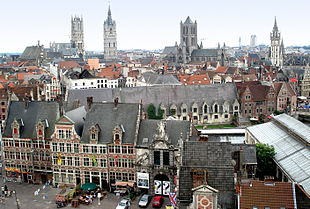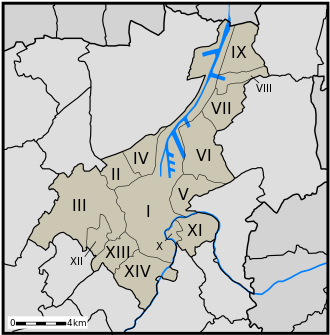Ghent
![]()
The title of this article is ambiguous. For other meanings, see Ghent (disambiguation).
lblelslh
Ghent (Dutch [ɣɛnt]/[ʝɛnt], French Gand [gɑ̃]) is the second largest city in Belgium after Antwerp. It is also the capital of the province of East Flanders and of the arrondissement and electoral district.
Ghent originated from Celtic settlements in the area where the Scheldt and Leie rivers meet. In the Middle Ages, Ghent grew into one of the largest and most important cities in Europe due to the flourishing cloth trade. The flax and linen trade and the right to stack grain acquired by the city also contributed considerably to the city's prosperity. After a brief Calvinist period, the city declined visibly until it flourished again towards the end of the 18th century, when Ghent became one of the first industrialised cities on the European mainland.
In the Hof ten Walle, later the Prinzenhof, the future Emperor Charles V was born on 24 February 1500. The pacification of Ghent (1576) and the Peace of Ghent (1814) were also signed in the city.
Ghent is also called "the proud city" (de fiere stad) or - after the champions of its urban freedom - Artevelde city. Because of its location in an extensive area of flower and plant breeding farms, Ghent is also called the City of Flowers.
Patron saints of Ghent are Saint Lieven and Pharaildis. Saint Bavo is the patron saint of the diocese of Ghent, after him the Saint Bavo Abbey and later also the Saint Bavo Cathedral are named. The wealthy citizens of the city built the Sint-Niklaaskerk on the Kornmarkt in the 13th and 14th centuries.

View of Ghent from the north
Geography
Location
Ghent is located in the middle of an urban area. Brussels to the southeast and Antwerp to the northeast are both about 50 km away, while Bruges, Kortrijk and Roeselare are about 40 km away to the west. The city lies at the confluence of the Scheldt and the Leie. Ghent has a population of 262,219 as of 1 Jan 2019, with an area of 156.18 km², and a population growth rate of 0.6%.
Inhabitants
The metropolitan region of the city has an area of approximately 1205 km². It is home to 594,582 people (1 Jan. 2008), making the Ghent metropolitan area the fourth most populated in Belgium. The central agglomeration has 278,457 inhabitants, the closest surrounding area (banlieue) increases the number to 423,320. With the outermost residential and influence zone (forensenwoonzone) the number adds up to 594,582.
City centre
The city centre is divided into several nuclei dating back to earlier settlements, the difference between the historic medieval centre in the so-called "Wanne" (De Kuip) and the much higher area of the former Saint-Peters Abbey on the Blandinberg is particularly noticeable.
Climate
The city's climate is influenced by the nearby North Sea; daytime temperatures are usually pleasant in both summer and winter: night frosts are just as rare as midday temperatures of over 30 °C.
City breakdown
Overview
Today, Ghent does not only consist of the historical, densely built-up and inhabited city centre, consisting of the centre sitting in the "tub" and the abbey quarter on the Blandinberg. As in many other cities, around the original city area there are quarters that were built in the 19th and 20th centuries as working-class districts; here, too, there is a dense development. To the south lies the railway station district of the early 20th century. Beyond there begins the outskirts of the city, where development has taken place mainly along the major arterial roads, increasingly integrating the surrounding village centres. The city of Ghent is divided into 25 districts, which coincide with historical quarters and neighbourhoods, especially in the centre. Beyond that, the administrative division into sub-municipalities essentially coincides with the socio-cultural and historical division.
Since the mergers of 1965 and 1977, Ghent consists of the following sub-municipalities:
| # | Name | Area | Population |
| I | Gent |
| 112.831 |
| II | Mariakerke |
| 11.558 |
| III | Drongen |
| 12.213 |
| IV | Wondelgem |
| 12.327 |
| V | Sint-Amandsberg |
| 21.567 |
| VI | Oostakker |
| 13.457 |
| VII | Desteldonk |
|
|
| VIII | Mendonk |
|
|
| IX | Sint-Kruis-Winkel |
|
|
| X | Ledeberg |
| 7.955 |
| XI | Gentbrugge |
| 19.812 |
| XII | Afsnee |
|
|
| XIII | Sint-Denijs-Westrem |
| 6.755 |
| XIV | Zwijnaarde |
| 6.918 |
Neighboring communities
Ghent borders the following sub-municipalities:
- Wachtebeke (Wachtebeke municipality),
- Zaffelare (Lochristi parish),
- Lochristi, with the village Hijfte (municipality Lochristi)
- Destelbergen (Community of Destelbergen)
- Heusden (municipality of Destelbergen)
- Melle (Community of Melle)
- Merelbeke (Community of Merelbeke)
- Zevergem (municipality of De Pinte)
- De Pinte (Community of De Pinte)
- Sint-Martens-Latem (Municipality of Sint-Martens-Latem)
- Sint-Martens-Leerne (municipality of Deinze)
- Vosselare (Municipality of Nevele)
- Landegem (municipality of Nevele)
- Merendree (Nevele parish)
- Vinderhoute (Municipality of Lovendegem)
- Lovendegem (Municipality of Lovendegem)
- Evergem, with the villages Belzele and Wippelgem (municipality of Evergem)
- Kluizen (Municipality of Evergem)
- Ertvelde, with the village of Rieme (municipality of Evergem)
- Zelzate (Community of Zelzate)

Sub-communities
Search within the encyclopedia